Changdi Yang
Open-Source Multimodal Moxin Models with Moxin-VLM and Moxin-VLA
Dec 22, 2025Abstract:Recently, Large Language Models (LLMs) have undergone a significant transformation, marked by a rapid rise in both their popularity and capabilities. Leading this evolution are proprietary LLMs like GPT-4 and GPT-o1, which have captured widespread attention in the AI community due to their remarkable performance and versatility. Simultaneously, open-source LLMs, such as LLaMA and Mistral, have made great contributions to the ever-increasing popularity of LLMs due to the ease to customize and deploy the models across diverse applications. Moxin 7B is introduced as a fully open-source LLM developed in accordance with the Model Openness Framework, which moves beyond the simple sharing of model weights to embrace complete transparency in training, datasets, and implementation detail, thus fostering a more inclusive and collaborative research environment that can sustain a healthy open-source ecosystem. To further equip Moxin with various capabilities in different tasks, we develop three variants based on Moxin, including Moxin-VLM, Moxin-VLA, and Moxin-Chinese, which target the vision-language, vision-language-action, and Chinese capabilities, respectively. Experiments show that our models achieve superior performance in various evaluations. We adopt open-source framework and open data for the training. We release our models, along with the available data and code to derive these models.
TSLA: A Task-Specific Learning Adaptation for Semantic Segmentation on Autonomous Vehicles Platform
Aug 17, 2025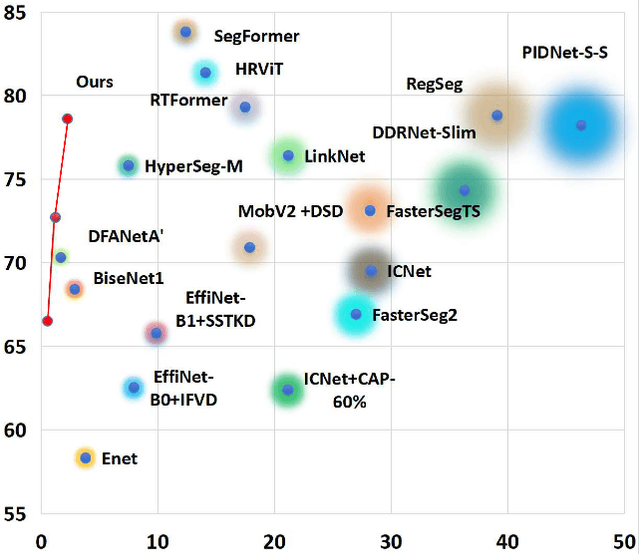
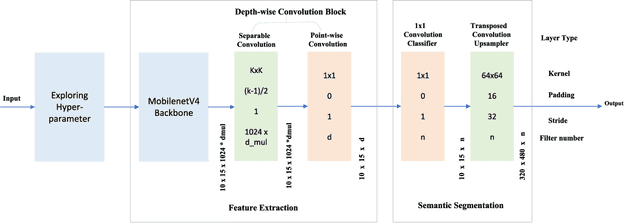
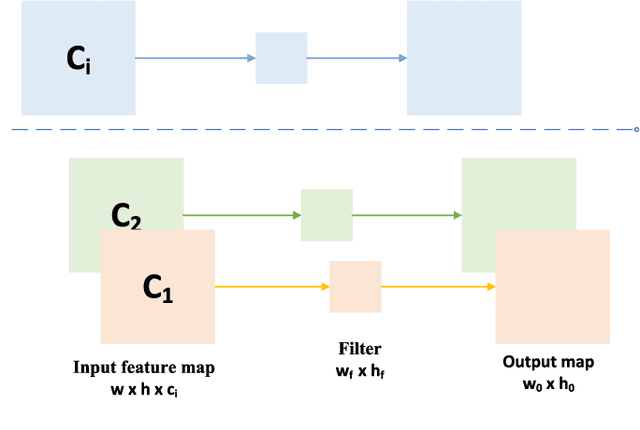
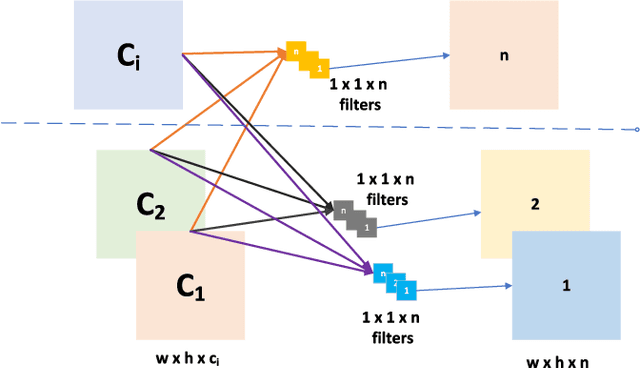
Abstract:Autonomous driving platforms encounter diverse driving scenarios, each with varying hardware resources and precision requirements. Given the computational limitations of embedded devices, it is crucial to consider computing costs when deploying on target platforms like the NVIDIA\textsuperscript{\textregistered} DRIVE PX 2. Our objective is to customize the semantic segmentation network according to the computing power and specific scenarios of autonomous driving hardware. We implement dynamic adaptability through a three-tier control mechanism -- width multiplier, classifier depth, and classifier kernel -- allowing fine-grained control over model components based on hardware constraints and task requirements. This adaptability facilitates broad model scaling, targeted refinement of the final layers, and scenario-specific optimization of kernel sizes, leading to improved resource allocation and performance. Additionally, we leverage Bayesian Optimization with surrogate modeling to efficiently explore hyperparameter spaces under tight computational budgets. Our approach addresses scenario-specific and task-specific requirements through automatic parameter search, accommodating the unique computational complexity and accuracy needs of autonomous driving. It scales its Multiply-Accumulate Operations (MACs) for Task-Specific Learning Adaptation (TSLA), resulting in alternative configurations tailored to diverse self-driving tasks. These TSLA customizations maximize computational capacity and model accuracy, optimizing hardware utilization.
RCR-Router: Efficient Role-Aware Context Routing for Multi-Agent LLM Systems with Structured Memory
Aug 06, 2025Abstract:Multi-agent large language model (LLM) systems have shown strong potential in complex reasoning and collaborative decision-making tasks. However, most existing coordination schemes rely on static or full-context routing strategies, which lead to excessive token consumption, redundant memory exposure, and limited adaptability across interaction rounds. We introduce RCR-Router, a modular and role-aware context routing framework designed to enable efficient, adaptive collaboration in multi-agent LLMs. To our knowledge, this is the first routing approach that dynamically selects semantically relevant memory subsets for each agent based on its role and task stage, while adhering to a strict token budget. A lightweight scoring policy guides memory selection, and agent outputs are iteratively integrated into a shared memory store to facilitate progressive context refinement. To better evaluate model behavior, we further propose an Answer Quality Score metric that captures LLM-generated explanations beyond standard QA accuracy. Experiments on three multi-hop QA benchmarks -- HotPotQA, MuSiQue, and 2WikiMultihop -- demonstrate that RCR-Router reduces token usage (up to 30%) while improving or maintaining answer quality. These results highlight the importance of structured memory routing and output-aware evaluation in advancing scalable multi-agent LLM systems.
ALTER: All-in-One Layer Pruning and Temporal Expert Routing for Efficient Diffusion Generation
May 27, 2025Abstract:Diffusion models have demonstrated exceptional capabilities in generating high-fidelity images. However, their iterative denoising process results in significant computational overhead during inference, limiting their practical deployment in resource-constrained environments. Existing acceleration methods often adopt uniform strategies that fail to capture the temporal variations during diffusion generation, while the commonly adopted sequential pruning-then-fine-tuning strategy suffers from sub-optimality due to the misalignment between pruning decisions made on pretrained weights and the model's final parameters. To address these limitations, we introduce ALTER: All-in-One Layer Pruning and Temporal Expert Routing, a unified framework that transforms diffusion models into a mixture of efficient temporal experts. ALTER achieves a single-stage optimization that unifies layer pruning, expert routing, and model fine-tuning by employing a trainable hypernetwork, which dynamically generates layer pruning decisions and manages timestep routing to specialized, pruned expert sub-networks throughout the ongoing fine-tuning of the UNet. This unified co-optimization strategy enables significant efficiency gains while preserving high generative quality. Specifically, ALTER achieves same-level visual fidelity to the original 50-step Stable Diffusion v2.1 model while utilizing only 25.9% of its total MACs with just 20 inference steps and delivering a 3.64x speedup through 35% sparsity.
Structured Agent Distillation for Large Language Model
May 20, 2025



Abstract:Large language models (LLMs) exhibit strong capabilities as decision-making agents by interleaving reasoning and actions, as seen in ReAct-style frameworks. Yet, their practical deployment is constrained by high inference costs and large model sizes. We propose Structured Agent Distillation, a framework that compresses large LLM-based agents into smaller student models while preserving both reasoning fidelity and action consistency. Unlike standard token-level distillation, our method segments trajectories into {[REASON]} and {[ACT]} spans, applying segment-specific losses to align each component with the teacher's behavior. This structure-aware supervision enables compact agents to better replicate the teacher's decision process. Experiments on ALFWorld, HotPotQA-ReAct, and WebShop show that our approach consistently outperforms token-level and imitation learning baselines, achieving significant compression with minimal performance drop. Scaling and ablation results further highlight the importance of span-level alignment for efficient and deployable agents.
QuartDepth: Post-Training Quantization for Real-Time Depth Estimation on the Edge
Mar 20, 2025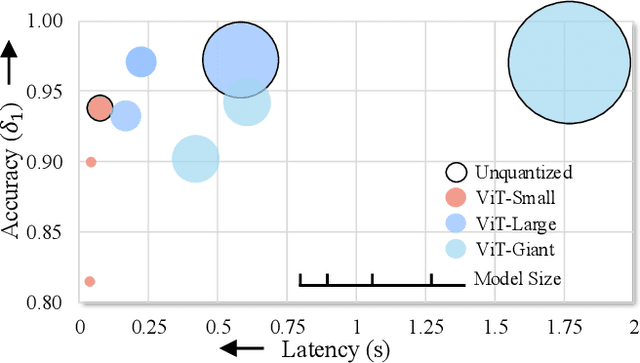
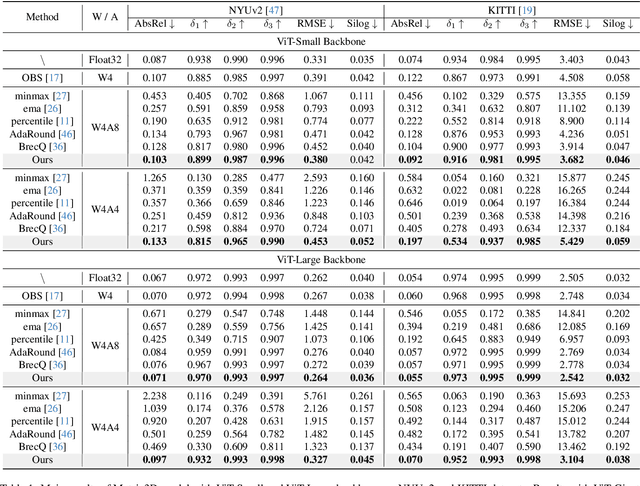
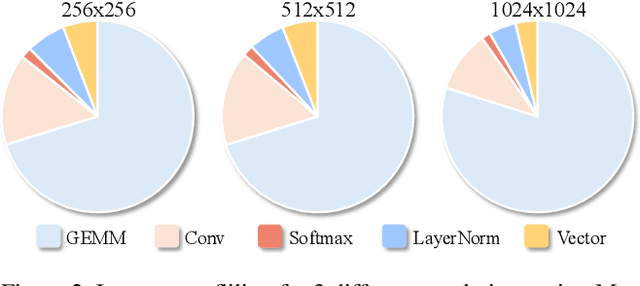

Abstract:Monocular Depth Estimation (MDE) has emerged as a pivotal task in computer vision, supporting numerous real-world applications. However, deploying accurate depth estimation models on resource-limited edge devices, especially Application-Specific Integrated Circuits (ASICs), is challenging due to the high computational and memory demands. Recent advancements in foundational depth estimation deliver impressive results but further amplify the difficulty of deployment on ASICs. To address this, we propose QuartDepth which adopts post-training quantization to quantize MDE models with hardware accelerations for ASICs. Our approach involves quantizing both weights and activations to 4-bit precision, reducing the model size and computation cost. To mitigate the performance degradation, we introduce activation polishing and compensation algorithm applied before and after activation quantization, as well as a weight reconstruction method for minimizing errors in weight quantization. Furthermore, we design a flexible and programmable hardware accelerator by supporting kernel fusion and customized instruction programmability, enhancing throughput and efficiency. Experimental results demonstrate that our framework achieves competitive accuracy while enabling fast inference and higher energy efficiency on ASICs, bridging the gap between high-performance depth estimation and practical edge-device applicability. Code: https://github.com/shawnricecake/quart-depth
Fully Open Source Moxin-7B Technical Report
Dec 08, 2024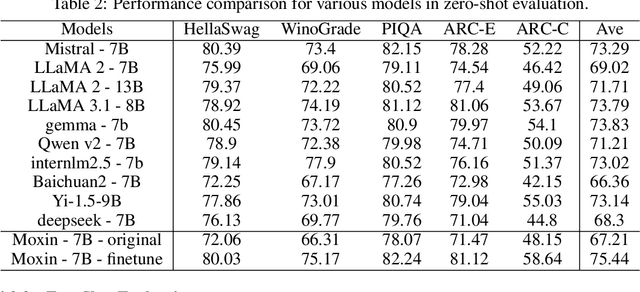
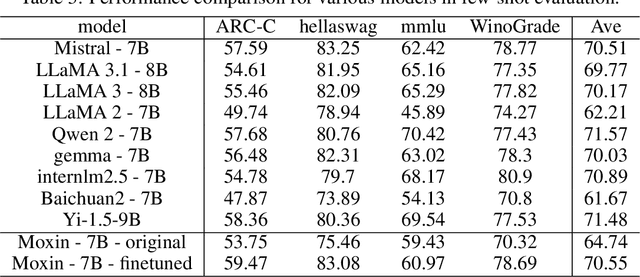
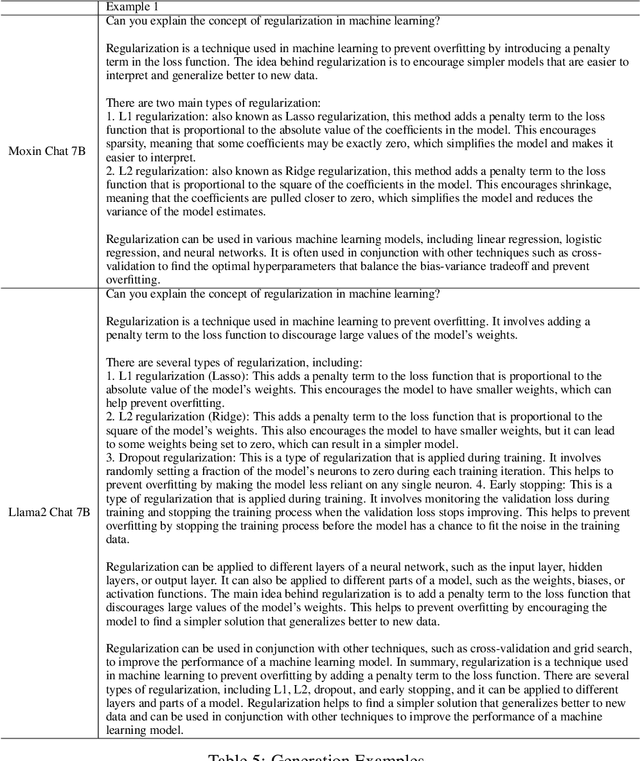
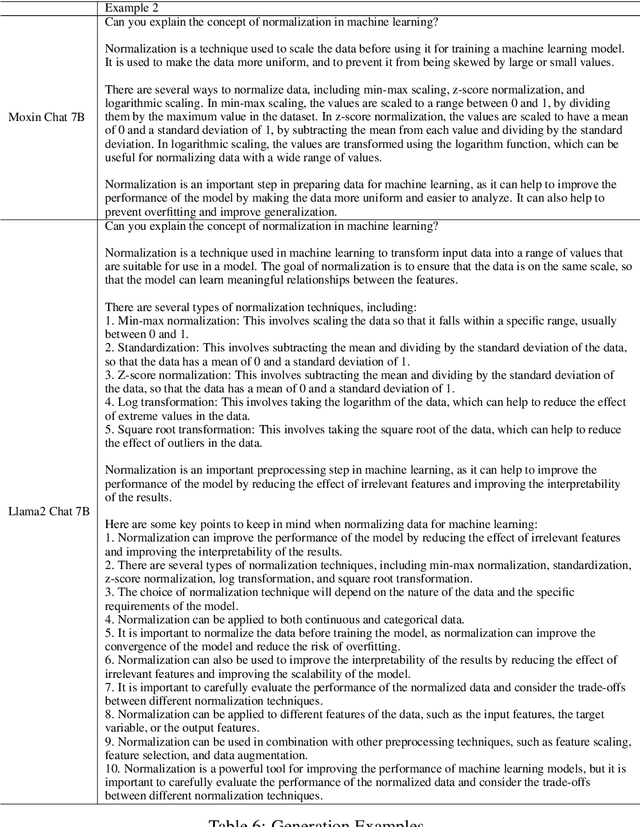
Abstract:Recently, Large Language Models (LLMs) have undergone a significant transformation, marked by a rapid rise in both their popularity and capabilities. Leading this evolution are proprietary LLMs like GPT-4 and GPT-o1, which have captured widespread attention in the AI community due to their remarkable performance and versatility. Simultaneously, open-source LLMs, such as LLaMA and Mistral, have made great contributions to the ever-increasing popularity of LLMs due to the ease to customize and deploy the models across diverse applications. Although open-source LLMs present unprecedented opportunities for innovation and research, the commercialization of LLMs has raised concerns about transparency, reproducibility, and safety. Many open-source LLMs fail to meet fundamental transparency requirements by withholding essential components like training code and data, and some use restrictive licenses whilst claiming to be "open-source," which may hinder further innovations on LLMs. To mitigate this issue, we introduce Moxin 7B, a fully open-source LLM developed in accordance with the Model Openness Framework (MOF), a ranked classification system that evaluates AI models based on model completeness and openness, adhering to principles of open science, open source, open data, and open access. Our model achieves the highest MOF classification level of "open science" through the comprehensive release of pre-training code and configurations, training and fine-tuning datasets, and intermediate and final checkpoints. Experiments show that our model achieves superior performance in zero-shot evaluation compared with popular 7B models and performs competitively in few-shot evaluation.
Fast and Memory-Efficient Video Diffusion Using Streamlined Inference
Nov 02, 2024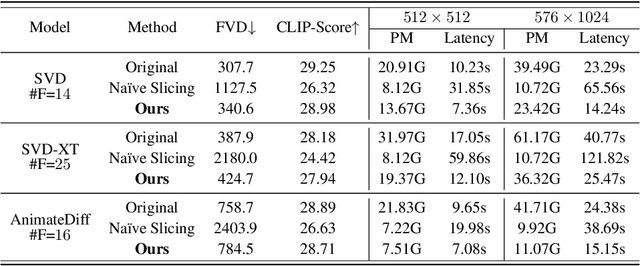
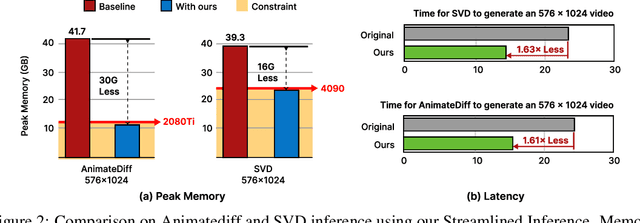

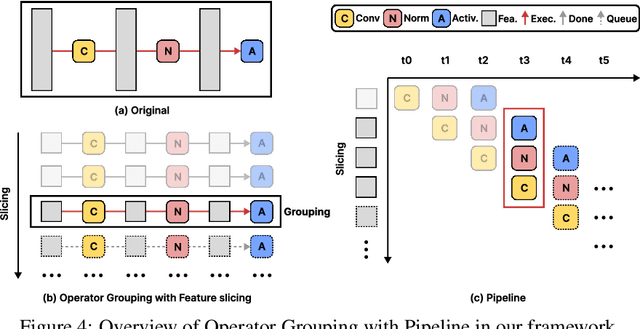
Abstract:The rapid progress in artificial intelligence-generated content (AIGC), especially with diffusion models, has significantly advanced development of high-quality video generation. However, current video diffusion models exhibit demanding computational requirements and high peak memory usage, especially for generating longer and higher-resolution videos. These limitations greatly hinder the practical application of video diffusion models on standard hardware platforms. To tackle this issue, we present a novel, training-free framework named Streamlined Inference, which leverages the temporal and spatial properties of video diffusion models. Our approach integrates three core components: Feature Slicer, Operator Grouping, and Step Rehash. Specifically, Feature Slicer effectively partitions input features into sub-features and Operator Grouping processes each sub-feature with a group of consecutive operators, resulting in significant memory reduction without sacrificing the quality or speed. Step Rehash further exploits the similarity between adjacent steps in diffusion, and accelerates inference through skipping unnecessary steps. Extensive experiments demonstrate that our approach significantly reduces peak memory and computational overhead, making it feasible to generate high-quality videos on a single consumer GPU (e.g., reducing peak memory of AnimateDiff from 42GB to 11GB, featuring faster inference on 2080Ti).
Rethinking Token Reduction for State Space Models
Oct 16, 2024



Abstract:Recent advancements in State Space Models (SSMs) have attracted significant interest, particularly in models optimized for parallel training and handling long-range dependencies. Architectures like Mamba have scaled to billions of parameters with selective SSM. To facilitate broader applications using Mamba, exploring its efficiency is crucial. While token reduction techniques offer a straightforward post-training strategy, we find that applying existing methods directly to SSMs leads to substantial performance drops. Through insightful analysis, we identify the reasons for this failure and the limitations of current techniques. In response, we propose a tailored, unified post-training token reduction method for SSMs. Our approach integrates token importance and similarity, thus taking advantage of both pruning and merging, to devise a fine-grained intra-layer token reduction strategy. Extensive experiments show that our method improves the average accuracy by 5.7% to 13.1% on six benchmarks with Mamba-2 compared to existing methods, while significantly reducing computational demands and memory requirements.
Efficient Pruning of Large Language Model with Adaptive Estimation Fusion
Mar 16, 2024Abstract:Large language models (LLMs) have become crucial for many generative downstream tasks, leading to an inevitable trend and significant challenge to deploy them efficiently on resource-constrained devices. Structured pruning is a widely used method to address this challenge. However, when dealing with the complex structure of the multiple decoder layers, general methods often employ common estimation approaches for pruning. These approaches lead to a decline in accuracy for specific downstream tasks. In this paper, we introduce a simple yet efficient method that adaptively models the importance of each substructure. Meanwhile, it can adaptively fuse coarse-grained and finegrained estimations based on the results from complex and multilayer structures. All aspects of our design seamlessly integrate into the endto-end pruning framework. Our experimental results, compared with state-of-the-art methods on mainstream datasets, demonstrate average accuracy improvements of 1.1%, 1.02%, 2.0%, and 1.2% for LLaMa-7B,Vicuna-7B, Baichuan-7B, and Bloom-7b1, respectively.
 Add to Chrome
Add to Chrome Add to Firefox
Add to Firefox Add to Edge
Add to Edge